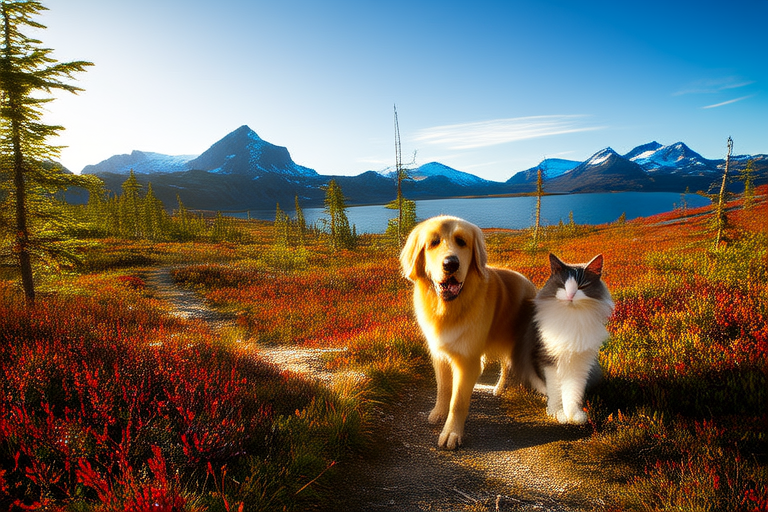Pet Raising Practices Among Norwegians: Unique Challenges and Benefits of Fjord Landscape
Norway is renowned for its stunning fjords, mountains, and vast wilderness. This unique geographical setting presents both challenges and benefits for pet owners. From the hardy local breeds that have adapted to the harsh climate to the community-oriented approach to pet care, Norwegian pet raising practices reflect the country’s rich cultural heritage and environmental awareness. This article explores these aspects in detail.
Local Breeds and Adaptation to Climate
The Norwegian Buhund and the Lundehund are two of the most iconic local breeds. The Norwegian Buhund, a herding dog known for its intelligence and loyalty, has been bred to withstand the cold and rugged terrain of Norway’s fjords. Similarly, the Lundehund, with its unique anatomical features, including flexible joints and extra toes, was originally used for hunting puffins. These breeds exemplify the adaptation of animals to their environment.
The harsh winters of Norway require careful attention to pets’ coats. Many dogs are double-coated, providing insulation against the cold. Pet owners ensure their pets remain warm by providing insulated bedding and outdoor shelters. During winter, it’s common to see dogs wearing sweaters or coats when going out for walks. Additionally, pet diets often include more fat-rich foods to help them maintain body heat.
Dietary Habits Influenced by Climate
The cold climate influences the dietary habits of pets in Norway. High-protein diets are prevalent, as they provide the necessary energy for pets to stay warm. Fish and fish oil are common ingredients in pet food, reflecting the abundance of marine resources in Norwegian waters. Omega-3 fatty acids found in fish oils promote healthy skin and coat, essential for keeping pets warm and comfortable during long, cold winters.
Vitamins and minerals are also important components of pet diets. Vitamin D, for example, is crucial for bone health, especially during the long periods of darkness in winter. Some pet owners choose to supplement their pets’ diets with vitamin D drops to ensure they receive adequate amounts.
Outdoor Activity Adaptations for Varying Seasons
The changing seasons in Norway necessitate adjustments in outdoor activities for pets. In summer, when the days are long, many pet owners take advantage of the extended daylight hours to engage in outdoor activities. Hiking, swimming, and playing fetch in the fjords are popular pastimes. However, during the short winter days, indoor activities become more prominent. Puzzle toys, interactive games, and training sessions are excellent ways to keep pets mentally stimulated.
Winter poses unique challenges for outdoor activities. Snowshoeing and sledding with dogs are popular winter sports. Many Norwegians participate in dog sledding events, which not only provide exercise for the dogs but also foster a sense of community among pet owners. Additionally, some pet owners use heated dog boots to protect their pets’ paws from the cold and ice.
Cultural Attitudes Towards Pets
In Norway, pets are considered part of the family, and this sentiment is reflected in the high standards of care provided. Pets are often included in family outings, vacations, and even work-from-home setups. Many offices and cafes in Norway are pet-friendly, allowing owners to bring their pets along while working or enjoying a coffee break.
The Norwegian attitude towards pets extends beyond the home. There is a strong emphasis on responsible pet ownership, which includes neutering, vaccinations, and microchipping. The government provides financial support for low-income families to spay or neuter their pets, ensuring that all animals receive proper care regardless of their owner’s financial situation.
Community Involvement in Pet Care
Community involvement plays a significant role in pet care in Norway. Local animal shelters and rescue organizations work closely with the government to ensure that all animals receive proper care. Many communities organize events such as adoption fairs, where people can meet and adopt pets from shelters.
Volunteer programs are also common, allowing individuals to contribute to the welfare of animals in their community. For example, some volunteers offer to walk elderly dogs or provide companionship to animals in shelters. These initiatives foster a sense of community and responsibility towards pets.
Laws and Norms Affecting Pet Ownership
Norway has strict laws regarding pet ownership to ensure the well-being of animals. All dogs must be registered with the Norwegian Kennel Club, and owners are required to pay an annual fee. This system helps track the number of dogs in the country and ensures that all dogs are properly vaccinated and microchipped.
There are also regulations concerning the import of pets. To prevent the spread of diseases, pets entering Norway must undergo quarantine and vaccination requirements. These measures protect both imported and native animals from potential health risks.
Conclusion
Raising pets in Norway’s fjord landscape comes with its own set of challenges and benefits. The unique environment requires careful consideration of diet, outdoor activities, and community involvement. However, the cultural attitudes towards pets and the strong legal framework in place ensure that all animals receive the care and attention they deserve. As Norway continues to evolve, so too will its pet raising practices, reflecting the country’s commitment to environmental sustainability and animal welfare.
